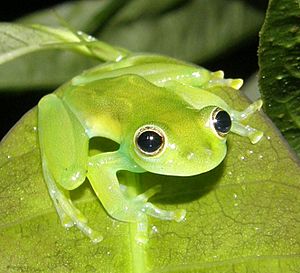Teratohyla spinosa facts for kids
Quick facts for kids Teratohyla spinosa |
|
|---|---|
 |
|
| Conservation status | |
| Scientific classification | |
| Synonyms | |
|
Centrolenella spinosa Taylor, 1949 |
The Teratohyla spinosa, also known as the spiny Cochran frog, is a small frog. It belongs to the Centrolenidae family, which are often called "glass frogs" because some have see-through skin! This frog lives in parts of Central and South America. You can find it in countries like Ecuador, Colombia, Panama, Costa Rica, Nicaragua, and Honduras. It lives in both the Pacific and Caribbean lowland areas.
Contents
What Does It Look Like?
The spiny Cochran frog is a small, green frog. It has big eyes that stick out a bit. Male frogs are about 18 to 20 millimeters long. Female frogs are a little bigger, growing to about 20 to 23 millimeters. That's less than an inch long!
When they are young Tadpoles and ready to change into frogs, they are about 16 millimeters long. Adult male frogs have a special spine. It's found at the bottom of their thumb.
Life Cycle and Sounds
Male spiny Cochran frogs make calls during the wet season. This is usually from May to October. They call from low plants near small streams. These calls help them find mates.
Female frogs lay their eggs on the underside of plants. They lay about 18 to 25 eggs. The eggs are in a single layer of loose jelly. After the eggs hatch, the young larvae grow in the streams.
Where Does It Live?
The spiny Cochran frog lives in warm, wet forests. These are called lowland primary humid forests. You can find them at heights between 20 and 800 meters above sea level. They like to stay near streams. They hide in the low plants along the water.
How Is It Doing?
The places where these frogs live are facing some threats. One big threat is deforestation. This means forests are being cut down. However, the spiny Cochran frog is found in many places. It also seems to have a large population. Because of this, experts do not think it is currently in danger. It is listed as "Least Concern" by conservation groups.
Images for kids
See also
 In Spanish: Teratohyla spinosa para niños
In Spanish: Teratohyla spinosa para niños



